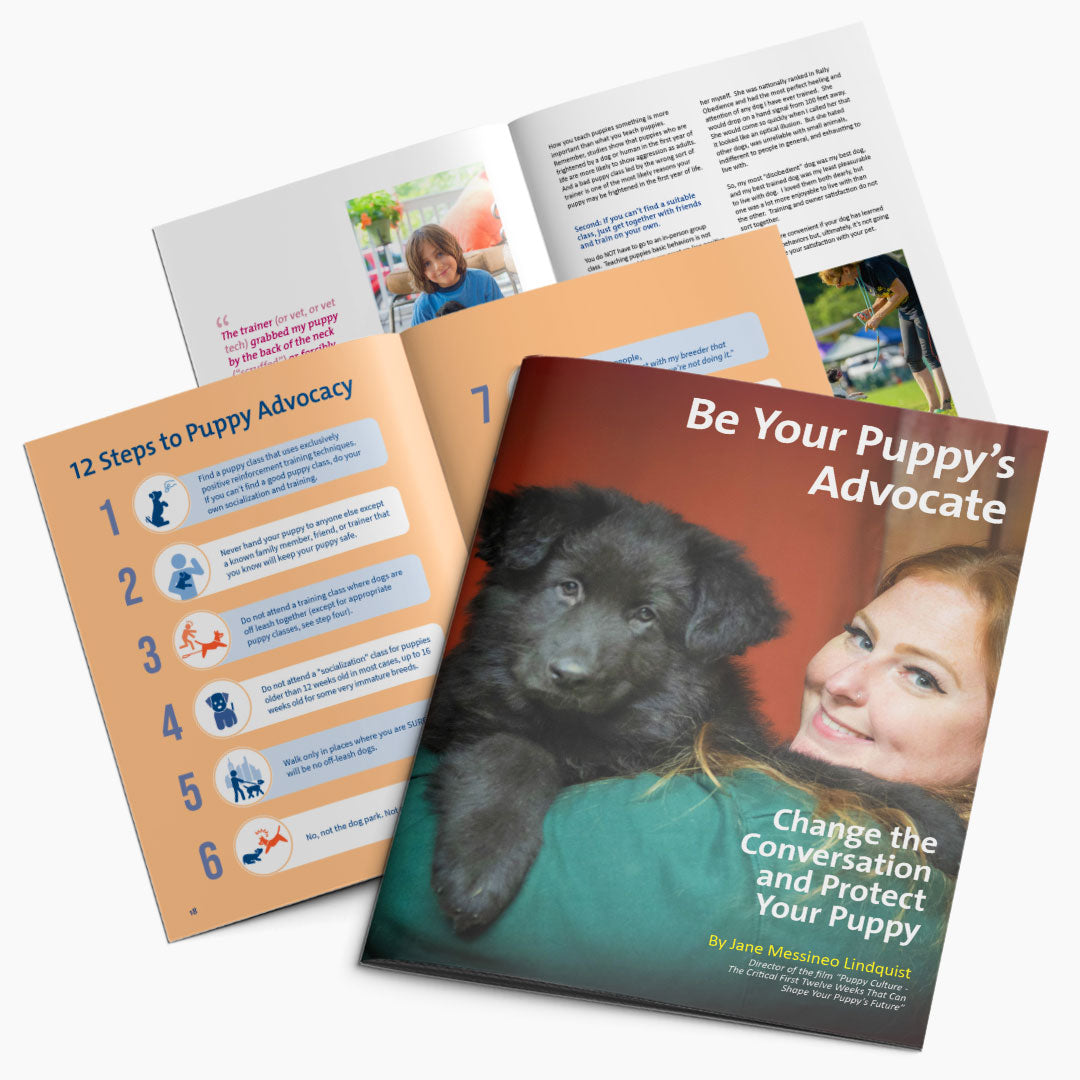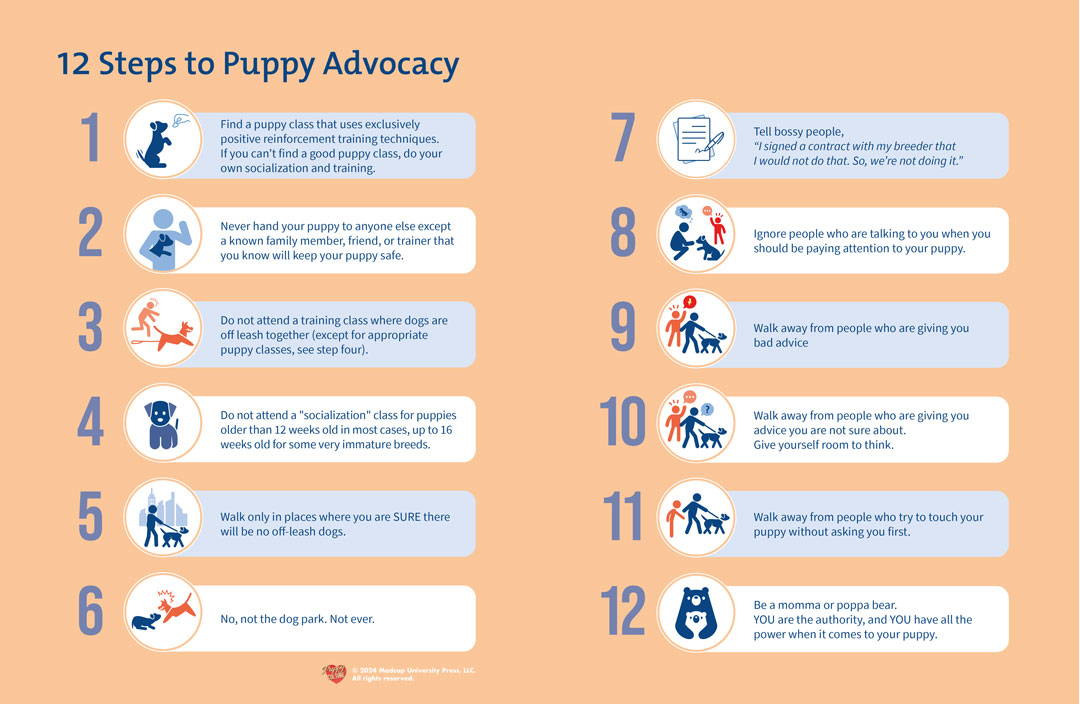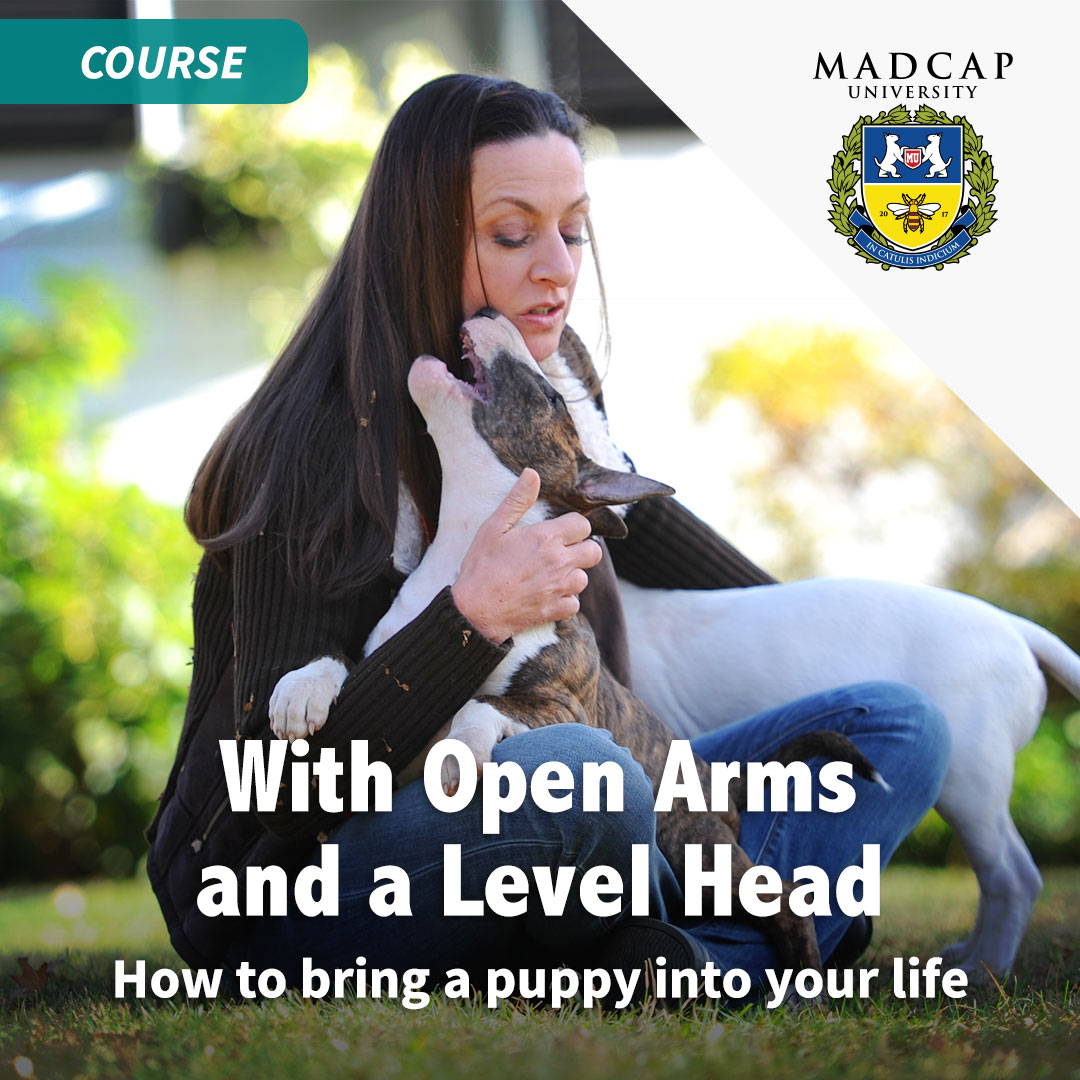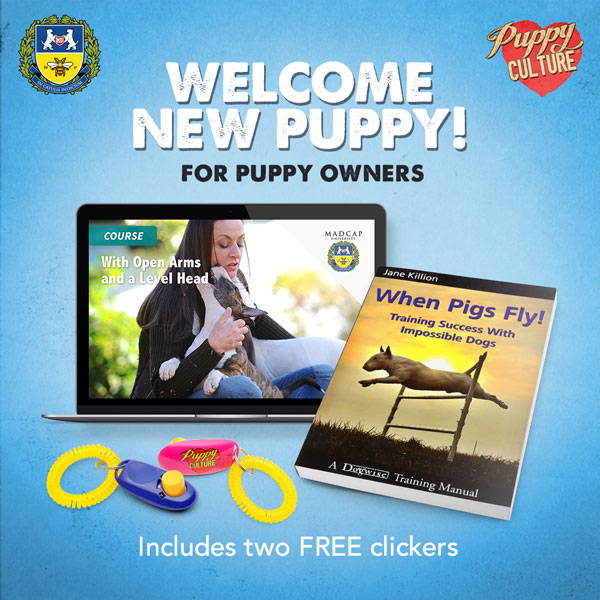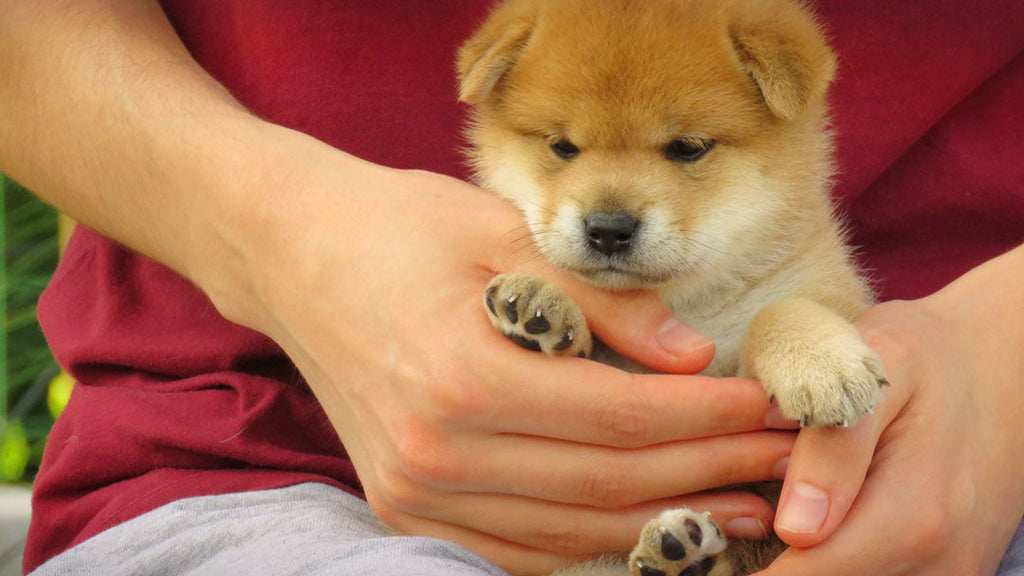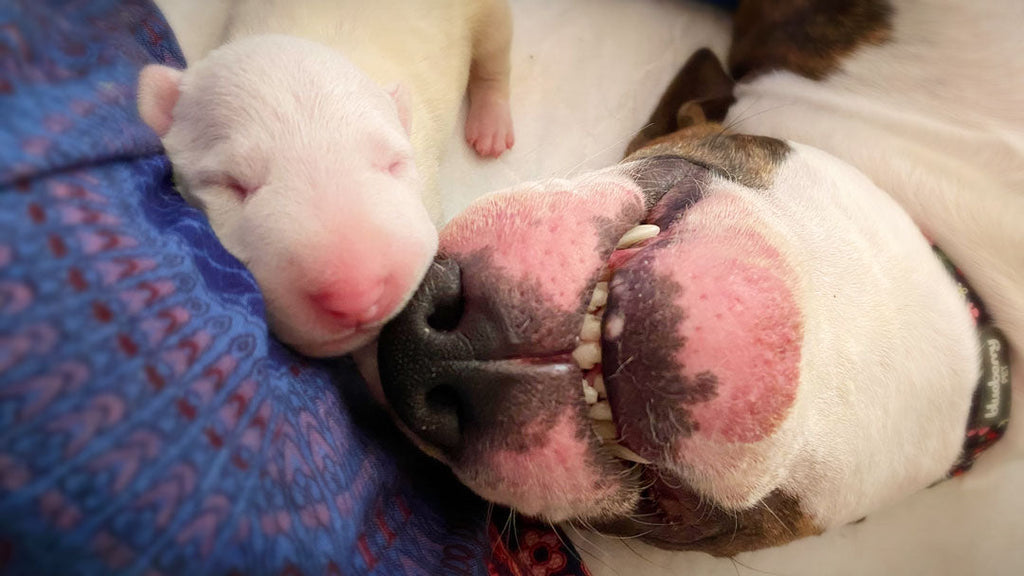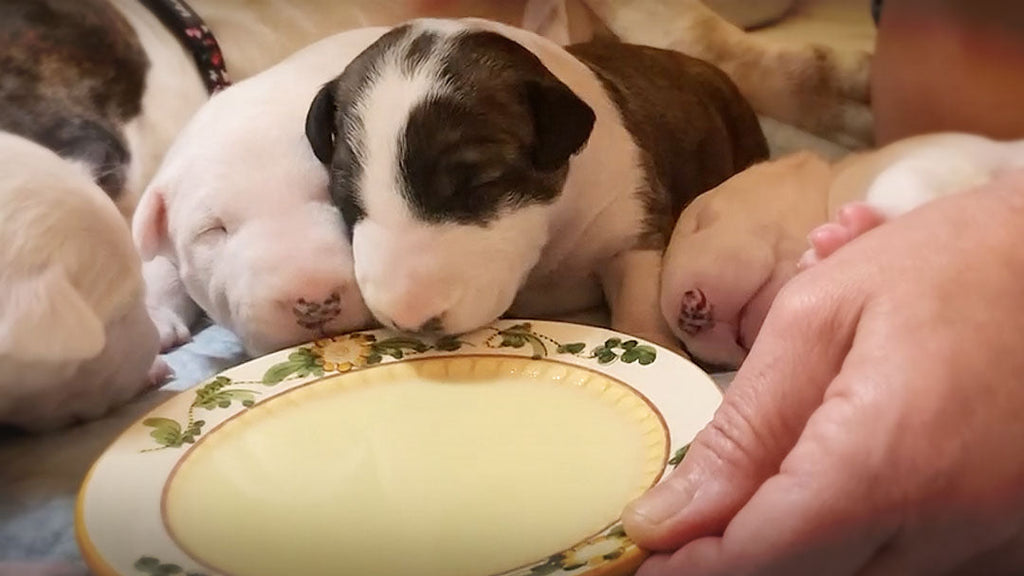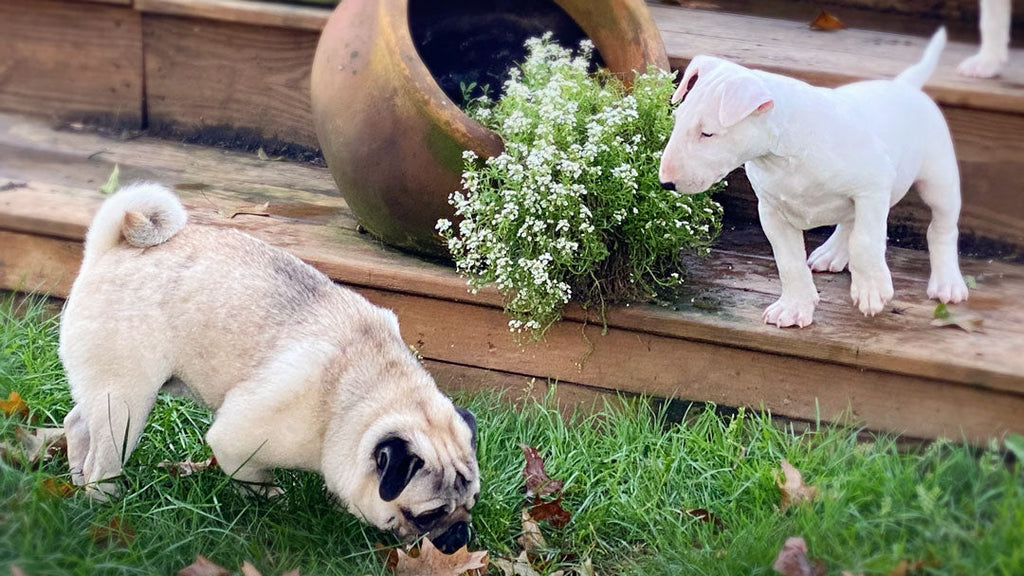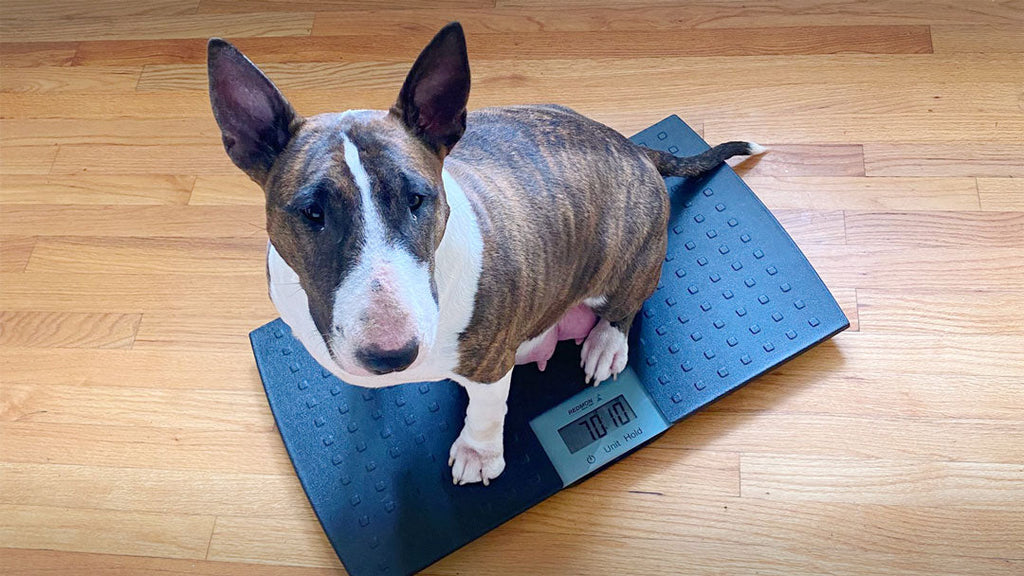Be Your Puppy’s Advocate
Change the Conversation
and Protect Your Puppy

This is a true story. And it’s a very familiar one, unfortunately. We hear some version of it on a regular basis:
I took my puppy to a trainer who had all kinds of great credentials. He came highly recommended.
He took the leash from me to demonstrate something with my puppy, and then suddenly slammed my puppy to the floor and forced it to lie down. Now my puppy trembles when she lies down and is so nervous that she will not take food.
Are you cringing as you read this? That poor puppy owner! Her puppy is emotionally damaged and it’s all the instructor’s fault!
But what if it isn’t all the instructor’s fault?
The truth is that this incident was foreseeable and preventable. And it’s your responsibility as a puppy owner to foresee and prevent things like this from happening.
This is not to blame puppy owners who’ve had bad experiences such as this. They did not know any better and were too trusting. But it doesn’t have to be that way. Instead of being victims along with our puppies, we must learn to be our puppies’ advocates.
You can prevent bad experiences for your puppy if you just know enough to avoid them. They’re almost never random things that happen. They’re almost always predictable IF you know in advance what to watch out for.
This article will arm you with the information and confidence you need to be your puppy’s advocate and keep your puppy safe.

Being your puppy’s advocate means having the knowledge and confidence to stand up to people and situations that could threaten your puppy’s welfare.
What’s at Stake?
It’s worth the effort to protect your puppy. Studies have shown1 that bad experiences in the first year of a puppy’s life are highly predictive of later aggression towards dogs and humans.
After a negative experience, the puppy may seem to be just scared, not aggressive. Or the puppy may even seem to get over it entirely.
But that bad experience is spooled in memory until later. When the puppy becomes a teenager his full defense instinct kicks in. His delayed reaction to that experience may then emerge as aggression.
That’s why we sometimes see a 12–18-month-old dog suddenly become aggressive toward people or other dogs, “out of nowhere.” So, it’s worth the effort to protect your puppy, especially in that first year of life.
Yes, bad things can happen no matter what you do. That’s where we hope that early emotional foundation work will kick in and serve the puppy. But, make no mistake, it’s very, very, hard to undo the effects of even one bad experience for a puppy or young dog.
Why is it so hard to “undo” these bad experiences? Well, the emotional sensitivity that makes socialization possible cuts both ways. Sure, your puppy can learn to love new people and things with as little as one exposure. But your puppy can imprint a bad experience just as quickly. So read on and learn how to advocate for your puppy!

This article is now available to purchase as a printed full color 20 page booklet.
Available now from puppyculture.com
Part One: Learning What’s Predictable
We have a duty to foresee situations that could put our puppies in harm’s way.
When something bad happens to someone’s puppy, we all rally around and support the puppy owner and talk about what jerks those other people are, but so what? That puppy owner may be “right” but that doesn’t change the fact that their puppy is now emotionally damaged.
So, let me help you keep your puppy safe by alerting you to very common yet avoidable incidents.
The trainer (or vet, or vet tech) grabbed my puppy by the back of the neck(“scruffed”) or forcibly rolled my puppy and shoved it onto its back on the ground (“alpha rolled”).
You can’t assume, just because someone is a “professional,” that they will behave appropriately with your puppy. You need to be selective about where you take your puppy and with whom you allow him to interact. Here are three key points to keep in mind:
First: Find a puppy class that uses exclusively positive reinforcement-based training techniques.
There is a debate about training methods for adult dogs, and you are welcome to join that debate when your puppy grows up. But there is NO argument for using any kind of correction or anything other than treats and praise with a puppy under 12 weeks old. It’s like hitting or yelling at a three-year-old child. It’s wrong, don’t let anyone do it to your puppy.
Before you sign up for a puppy class, ask the instructor directly “do you use or advocate anything other than positive reinforcement methods.” If the instructor waffles or starts talking about balanced training or needing different tools for different dogs, RUN, do not walk, from that trainer.
It does not matter how highly credentialed the trainer is, it does not matter how much your friend who recommended them gushed to you about “results.” If the trainer will not come out and say they use exclusively positive reinforcement methods and no aversives, do not go to that trainer’s class or school.
How you teach puppies something is more important than what you teach puppies. Remember, studies show that puppies who are frightened by a dog or human in the first year of life are more likely to show aggression as adults. And a bad puppy class led by the wrong sort of trainer is one of the most likely reasons your puppy may be frightened in the first year of life.

You would never let someone hit or choke your child, yet puppy owners allow trainers to do that to their puppies every day. Use common sense, violence is never warranted on a baby.
Second: If you can’t find a suitable class, just get together with friends and train on your own.
You do NOT have to go to an in-person group class. Teaching puppies basic behaviors is not rocket science and there are great on-line positive reinforcement training resources. We have a puppy course in Madcap University (madcapuniversity.com) that will teach you everything you need to know in the safety of your own home.
I have decades of experience with raising scores of puppies and I’m going to tell you a dirty secret. You can be very happy with a nearly untrained dog. Trust me, your puppy needs very little actual training. A good puppy class has value for socialization and for teaching puppies to pay attention in a distracting environment. But your puppy does not need to learn to stay in a lineup of dogs, or have perfect off-leash heeling, or sit on a platform for hours. Shaping early emotional attachments and avoiding bad experiences are much more important than “obedience.”
The very best dog I ever owned did not even know how to lie down, but she was a pleasure to be with, every second of her life. I raised her myself and emphasized socialization and fun rather than obedience. She was a gentle soul with nothing but love for all other living things. She would look at me like I was joking if I called her and she could never be trusted off leash for one second, but she brought nothing but pleasure to my life.
The most challenging dog I ever owned was one I got as an older puppy and I did not start her myself. She was nationally ranked in Rally Obedience and had the most perfect heeling and attention of any dog I have ever trained. She would drop on a hand signal from 100 feet away. She would come so quickly when I called her that it looked like an optical illusion. But she hated other dogs, was unreliable with small animals, indifferent to people in general, and exhausting to live with.
So, my most “disobedient” dog was my best dog, and my best trained dog was my least pleasurable to live with dog. I loved them both dearly, but one was a lot more enjoyable to live with than the other. Training and owner satisfaction do not sort together.

Joy, not obedience, is the material that bonds us to our pets. Your puppy needs to learn some basic skills, but never at the cost of joy and trust.
Sure, it’s more convenient if your dog has learned some basic behaviors but, ultimately, it’s not going to determine your satisfaction with your pet.
What does determine your satisfaction with your pet is lack of aggression and lack of fearfulness. So, steer way clear of a class or trainer that does not use purely positive reinforcement training methods, even if you think they might be able to get “results” by using other methods. Those results may come at the cost of your puppy’s ultimate relationship with you. You don’t need what those trainers are selling.
Third: Never hand the leash or your puppy to anyone who is not personally known to you to be safe for your puppy.
If you are going to the vet and have multiple dogs or puppies, bring in one puppy at a time or roll them in in a crate on a dolly or use a stroller. Decline any offer for vet hospital staff to bring in any of your puppies or dogs.
One of my friends was bringing three older puppies into the vet. She had a vet tech bring in one puppy on leash for her. The puppy playfully jumped on the tech and the tech “alpha rolled”the puppy - forcibly rolled the puppy and shoved it onto its back on the ground. The puppy was shaking with fear and my friend lost her mind on the tech. Then one of the other clients in the lobby yelled at my friend for “spoiling” her puppy and said the tech was right, and a verbal brawl ensued. Yes, tech+client = a couple of jerks but it’s predictable to the point of, once again, being a “shame on me” moment if you let someone else have the leash.
Some veterinary hospitals are certified “fear free” hospitals and the staff at a “fear free” vet hospital is much more likely to be safe for your puppy. But why take the chance if you don’t have to?
The same is true for training class. We hope you take our advice and seek out a class with a trainer that says they use exclusively positive reinforcement training methods. But that does not mean that you should unconditionally trust a trainer that is not personally known to you to be a person who uses only positive reinforcement techniques. People can say anything and do something very different.
If you are in a class and the trainer is not personally known to you to be a trainer who will use exclusively positive reinforcement methods, do not allow the trainer to take the leash from you or train your puppy themselves. Ask them to coach you through it, instead. Say, “I really want to learn how to do this, will you please help me do it myself?”

A pet stroller is a safe way to move around multiple puppies or small dogs.
Another dog jumped attacked him in training agility/obedience class.
It happens EVERY DAY. By the time you read this, there will be another dog who’s been traumatized and now needs a year of remedial work. The owner will post all the details to social media, and everyone will agree and shake their fists, but they’re all missing the point. This is predictable and could have been avoided.
Do not go to a training class where dogs are off leash together.
The only time I will ever do an off-leash group class is if the other dogs are personally known to me to be friendly to other dogs. I never take anyone else’s word for it.
Socialization “play” classes should be for young puppies only. Under 12 weeks is ideal - 12-16 weeks can be OK depending on the puppies.
Maybe after my dogs are over three years old and have reached stable emotional maturity, I might go to an off-leash group class where I personally know and trust the instructor and I also personally know and trust the other dogs. But I understand that this is an assumption of the risk, and I am always on high alert.
I run my agility classes one dog at a time (exceptions are made for dogs that know each other). In my dog training seminars, my mantra is “The Dog On The Floor Has The Floor,” and all other dogs MUST be crated. Not everyone likes it but I’m opting for safety, and you should, too.

The socialization period is a developmental period in young puppies, generally under 12 weeks old, where they have very low aggression and high desire to interact with other puppies. Puppies in their socialization period can safely play in groups such as in a puppy class, but older puppies are not suitable for play group classes. Older puppies need to be in pairs, not groups, and they need to be more closely monitored to avoid serious conflict.
Another dog jumped/attacked him when out for a walk.
Again, fists on social media will be shaken at “those idiots” who let their dogs off leash and do not have control, and yes, verily, they are idiots and hateful and they are in the wrong, BUT it’s totally predictable to the point where you have to take some responsibility for putting your puppy in that position.
I do not take my young dogs for walks anywhere where there is the possibility of people having dogs off leash.
For the first year or two of their lives, they are walked only on show grounds, at agility/rally/obedience trials - anywhere where “professional” dog people are.
I will also walk puppies in urban areas and college campuses where there will be no off leash dogs.
Then, when I feel they’re ready to start longer walks and hikes (usually around 15-18 months) my rule is that we only walk on trails where there are actual mountainous parts where you need to scramble with your hands to get up the hill. This keeps the palookas away.
Flat and easy trails and strolling parks are hard no for my puppies and young dogs. Those venues bring out the “Sunday driver” pet owners who think Fluffy needs to be free from a leash to be happy, no matter what the actual leash laws are. Trails that include a nice scramble on your hands and knees up a steep hill tend to attract a more motivated, safety-conscious crowd. I have certainly met off-leash dogs on strenuous hikes, but the owners were aware of their dogs and had them on leash long before we were anywhere near each other.
Flat trails and walks on the sidewalk past the inevitable dog that rushes (or breaks through) the invisible fence are a “never” for some of my dogs and not until they are over three years old for the rock-solid ones.
Your dog does not need a walk at the expense of becoming aggressive to other dogs because he had a bad experience. Period.

City walks where you can be sure there are no off-leash dogs are a good bet with your puppy.
My puppy got attacked at the dog park.
No, not the dog park, not ever.
Taking your puppy to the dog park is asking for something bad to happen.
Dog parks are tinderboxes of behaviorally unpredictable dogs with unknown vaccination and disease status, handled by pet owners who are generally not good at reading dog behavior.
Most pet owners are unable to see warning signs that their dog is not safe to be around other dogs until their dog actually does harm to another dog. It happens with depressing frequency. It’s predictable that taking your puppy to a dog park will not end well for your puppy.
From traumatized puppies to lawsuits, we hear it all the time. There is no upside to a dog park for your puppy.
If you live in an urban area where a dog park is the only off-leash opportunity for play, find a private space to rent through an app such as “Sniffspot” and set up playdates with other puppies who are of a similar age and playstyle as your puppy.
Your local veterinarians are the best places to find puppies for playdates. They will know who has been in recently with a new puppy – leave your name and contact information with the vet hospital and ask them to share it with those new puppy owners. A gift of baked goods for the staff when you drop off your contact information will get the information out even more quickly!
I ran into some people at the (pet store, vet’s office, big box store – fill in the blank).They said their dog was friendly and I took their word for it, and then it attacked (or traumatized) my puppy.
Choose your friends, don’t let them choose you.
If you run into a random person with a dog that you don’t know, don’t allow your puppy to interact with that dog. If the owner of the other dog is very insistent about their dog being good with other dogs and wanting to let their dog meet your puppy, just say, “my puppy hasn’t been vaccinated, so he can’t meet other dogs.”

Have a shopping cart with a bed in it ready whenever you take your puppy to a store. Pick up your puppy and put him in the cart if anyone intrudes on your space with another dog.
Re-Thinking “Necessities”
Part of advocating for your puppy is to let go of some of the conventional notions of what is necessary and good for your puppy.
You 100% should train your puppy, but you don’t need to do it in a class if a good class is not available.
You 100% do need to socialize your puppy to other people and animals, but you can set up your own sessions.
You 100% do need to take your puppy to the vet, but you can and should walk out of any vet’s office that is not willing to allow you to handle your own puppy for a basic wellness exam. You should also leave any vet that is not willing to create a happy feeling about vet visits by giving your puppy cookies and treating them well.
You 100% do sometimes need to bring more than one pet to the vet at once, but if the vet is not willing to wait for you to bring them in one at a time or won’t allow you to bring them in on a dolly in a crate, find another vet.

Part Two: Learning to Stand Up For Yourself and Your Puppy
Knowing what’s right and what to watch out for is only half the battle.
You also must be empowered to stand up for what’s right and protect your puppy from what’s wrong, and that can be very difficult. It’s surprisingly crushing to be confronted regarding how you raise, train, feed, vaccinate, or care for your puppy. Here’s some wisdom on how to advocate for your puppy in the face of pressure.
Bossy People Are Everywhere
Even the MOST experienced dog owners feel pressure when confronted by a person in a position of authority, such as a veterinarian, dog trainer, or professional handler. When one of these types of people is pushing something that does not seem right to you, such as a feeding, medication, or vaccination protocol that you are not in agreement with, or insisting on a training technique that you think might scare or hurt your puppy, it can be very difficult and embarrassing to stand up for yourself and say no to them.
If you find yourself in an awkward situation with one of these bossy types and you don’t really know how to get out of it, blame it on your breeder. Tell the bossy person, “I signed a contract with my breeder (or rescue organization) stating I would not do that. So, what you’re suggesting is not an option.”
Even if your breeder or rescue organization really didn’t have you sign a contract saying you would not do that thing, it doesn’t matter. Say it anyway. Lie like a rug and protect your puppy.
I also give my puppy owners my card so they can hand it to the trainer/vet/handler and say, “you may contact my breeder directly if you have any questions.” This takes the heat off the inexperienced puppy owner and transfers it to me. I am in a much better position to stand my ground than the puppy/owner would be.
However you do it, the important thing is to prime yourself to be ready to say, “no, we’re not doing that.”

Puppy owners are often sweet and too trusting of people who present as “authority.”
You Eventually Will Always Get It Right
The basic difference between the average pet person and a dog breeder or mentor is how quickly they can apply their knowledge to any given situation. The breeders and mentors immediately know from long experience what is and is not right or safe for their puppies, whereas the average pet person needs time to think about it and check their notes.
You may not have a breeder or mentor who has your back when you’re confronted by a bossy person.
You may not have the wisdom and experience to immediately know what is right and what is not.
You may not have the extraordinary gumption required to stand up to highly credentialed people. Puppy owners are often sweet and too trusting of people who present as “authority.”
But you DO have the ability to figure out what’s right. You just might need the time to carefully think about it and maybe consult with your breeder or mentor. Always give yourself that time.
Whenever you’re not sure, whenever you feel hesitation, whenever you feel you’re being pushed, trust your instincts. Give yourself space to think.
Try saying, “That’s interesting, I’ll have to think about that.” That should cause any reasonable person to back off.
If the person does not accept that and is persistent and pushy and you’re not sure how to get out of it, look at your phone and say you just realized you forgot an appointment/need to make a call/have to take care of something. Then leave.
You have every right and even an obligation to question authority, but don’t bother to “take on” authoritative types. It’s not worth the emotional cost. Just leave. Use evasive action and buy time to consider what’s best.
Cultivate that inner voice that gives you permission to step away and give yourself breathing room to think. You’ll get it right.
No Offense
You might be concerned about offending someone by walking away from them or walking out of their class or office on a hunch or feeling. What if you’re wrong? What if the person really is giving you good advice? Remember this. Those people that have your puppy’s best interests in mind will understand. If someone gets mad at you for leaving, they are putting their ego first and that’s a pretty good sign that they are not a good person to coach you and your puppy. To quote Bernard Baruch,“ …those who mind don’t matter, and those who matter don’t mind.”
You Are Not Obligated To Be Polite
When you are with your puppy or dog, do not EVER be worried about what people think of you socially.
Ignore people who are persistently trying to talk to you when you should be focusing your attention on your puppy. Don’t even look at them. If they can’t read the room and see that you’re busy, that’s not your burden.
And, whenever you are out in public with your puppy, your attention should be focused on your puppy.
If your puppy is in a playgroup, you should be watching to make sure that nothing is scaring your puppy, or that he’s not getting overtired and starting to get wound up. You can’t rely on instructors to keep your puppy safe. You must be your puppy’s advocate. That means that you should be ready to step in and take your puppy out of that situation at any second, and you can’t do that if you’re locked in a conversation with another person.
If you’re training your puppy, you can’t train and talk to someone at the same time.
If you’re out walking your puppy, you should be continually monitoring your puppy to gauge his reaction to the environment and be ready to take him back to safety if something scares him or is too much for him. You need to be watching to make sure that no other people or dogs swoop in and scare him. That can happen in an instant, and you might miss it if you’re listening to Chatty Cathy go on about the township committee meeting.
If you do for some reason need or want to talk to someone while you’re with your puppy, ask the person to hang on for a second, and then pick your puppy up and hold him in your arms so you know he’s safe while you’re not paying attention to him. If your puppy is a giant breed and picking him up is not an option, then crouch/sit on the ground and hold your puppy in your lap.
But don’t expect to be able to have a long conversation while you’re holding your puppy. If the chat goes on and on, your puppy may start getting squirmy and cranky. This is normal and OK. Babies don’t like being restrained. Either the puppy is overtired and needs to go home or the puppy is under stimulated and it’s unfair to restrain him. It’s possible your puppy might need to go to the bathroom. If your puppy starts to squirm, you should treat it as a legitimate need. I suggest that you interrupt and say, “sorry, we have to go” and walk away.
Walk Away From Bad Advice
When you have a puppy, people feel they have license to visit their unsolicited and unwelcome advice on you. Perfect strangers will insist on sharing their “wisdom” and telling you where you’re “going wrong.” Whether it’s training or feeding or whether you let your dog on the couch, they will let you know what they think and how they are right and you are wrong. You don’t have to put up with this.
- If you have not asked for someone’s opinion and they insist on giving it to you, or
- If you did ask their opinion or pay for their services but their recommendation does not seem right to you, and you’re not sure how to get out of the situation
WALK AWAY from them. Literally, just walk away. No comments, no apologies, just put distance between you and the person.
If you feel like saying something, look at your phone and say, “Something just came up, excuse me” and then walk away. Or, say, “Oh wow, I just realized I forgot something, excuse me” and then walk away.
As we mentioned before, even if you’re just not sure if you’re comfortable or don’t really understand, walk away and give yourself space to think. If you’re questioning it, you need breathing room to decide what’s right.
Also walk away from anyone trying to touch your dog without your permission. They are probably sweet and well-intentioned but that’s irrelevant. Do not consider their feelings, they did not consider yours. Again, just put distance between you and the person and protect your puppy.

Meeting friendly strangers is great, but people should wait for your permission to touch your puppy.
Be a Momma (Or Poppa) Bear
Advocates don’t care what other people think.
Advocates care about protecting their puppies.
We are taught from a very young age to avoid angering or offending others. We feel we should always behave in a socially acceptable manner, even when that’s not in our best interest. Women often struggle with this more than men, especially in the face of people who present as “authority.” But you must override those feelings and put your and your puppy’s welfare ahead of social conventions. When it comes to your puppy, YOU are the authority, and YOU have all the power.
It feels awkward, at first, but you will get used to it and it will start to feel REALLY GOOD when you do the right thing by your puppy.

Changing the Conversation, Taking the Next Steps
Congratulations! Now you know that you are not a passive participant in what happens to your puppy. You can control his future.You are your puppy’s advocate!

Be Your Puppy’s Advocate Booklet
Presented in an easy to read format, with eye-catching infographics and illustrations.
Available now from Puppy Culture
For further reading and citations to the studies and findings mentioned in this article:
1 Serpell JA, Duffy DL. Aspects of Juvenile and Adolescent Environment Predict Aggression and Fear in 12-Month-Old Guide Dogs. Front Vet Sci. 2016 Jun 22
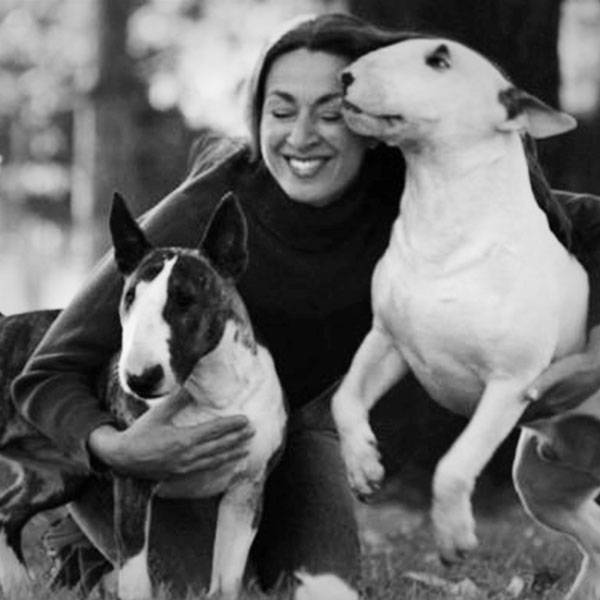
About the Author
Jane Messineo Lindquist (Killion) is the director of "Puppy Culture the Powerful First Twelve Weeks That Can Shape Your Puppies' Future" as well as the author of "When Pigs Fly: Training Success With Impossible Dogs" and founder of Madcap University.
Jane has had Bull Terriers since 1982 and she and her husband, Mark Lindquist, breed Bull Terriers under the Madcap kennel name.
Her interests include dog shows, dog agility, gardening, and any cocktail that involves an infused simple syrup.
Visit Jane's Websites
Recent Articles


